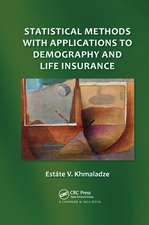Introduction to Machine Learning with Applications in Information Security: Chapman & Hall/CRC Machine Learning & Pattern Recognition
Autor Mark Stampen Limba Engleză Hardback – 12 iul 2017
Introduction to Machine Learning with Applications in Information Security provides a class-tested introduction to a wide variety of machine learning algorithms, reinforced through realistic applications. The book is accessible and doesn't prove theorems, or otherwise dwell on mathematical theory. The goal is to present topics at an intuitive level, with just enough detail to clarify the underlying concepts.
The book covers core machine learning topics in-depth, including Hidden Markov Models, Principal Component Analysis, Support Vector Machines, and Clustering. It also includes coverage of Nearest Neighbors, Neural Networks, Boosting and AdaBoost, Random Forests, Linear Discriminant Analysis, Vector Quantization, Naive Bayes, Regression Analysis, Conditional Random Fields, and Data Analysis.
Most of the examples in the book are drawn from the field of information security, with many of the machine learning applications specifically focused on malware. The applications presented are designed to demystify machine learning techniques by providing straightforward scenarios. Many of the exercises in this book require some programming, and basic computing concepts are assumed in a few of the application sections. However, anyone with a modest amount of programming experience should have no trouble with this aspect of the book.
Instructor resources, including PowerPoint slides, lecture videos, and other relevant material are provided on an accompanying website: http: //www.cs.sjsu.edu/ stamp/ML/. For the reader's benefit, the figures in the book are also available in electronic form, and in color.
About the Author
Mark Stamp has been a Professor of Computer Science at San Jose State University since 2002. Prior to that, he worked at the National Security Agency (NSA) for seven years, and a Silicon Valley startup company for two years. He received his Ph.D. from Texas Tech University in 1992. His love affair with machine learning began in the early 1990s, when he was working at the NSA, and continues today at SJSU, where he has supervised vast numbers of master's student projects, most of which involve a combination of information security and machine learning.
| Toate formatele și edițiile | Preț | Express |
|---|---|---|
| Paperback (1) | 351.59 lei 3-5 săpt. | +31.72 lei 7-13 zile |
| CRC Press – 19 dec 2024 | 351.59 lei 3-5 săpt. | +31.72 lei 7-13 zile |
| Hardback (2) | 410.54 lei 3-5 săpt. | +43.33 lei 7-13 zile |
| Taylor & Francis – 12 iul 2017 | 410.54 lei 3-5 săpt. | +43.33 lei 7-13 zile |
| CRC Press – 27 sep 2022 | 524.85 lei 6-8 săpt. |
Din seria Chapman & Hall/CRC Machine Learning & Pattern Recognition
- 20%
 Preț: 498.38 lei
Preț: 498.38 lei -
 Preț: 312.90 lei
Preț: 312.90 lei - 9%
 Preț: 644.74 lei
Preț: 644.74 lei - 20%
 Preț: 298.44 lei
Preț: 298.44 lei - 20%
 Preț: 494.73 lei
Preț: 494.73 lei -
 Preț: 353.69 lei
Preț: 353.69 lei -
 Preț: 357.34 lei
Preț: 357.34 lei - 20%
 Preț: 953.72 lei
Preț: 953.72 lei - 34%
 Preț: 591.54 lei
Preț: 591.54 lei -
 Preț: 418.78 lei
Preț: 418.78 lei - 29%
 Preț: 257.00 lei
Preț: 257.00 lei - 18%
 Preț: 787.21 lei
Preț: 787.21 lei - 29%
 Preț: 259.81 lei
Preț: 259.81 lei - 43%
 Preț: 266.41 lei
Preț: 266.41 lei - 26%
 Preț: 272.02 lei
Preț: 272.02 lei - 15%
 Preț: 436.04 lei
Preț: 436.04 lei - 28%
 Preț: 264.66 lei
Preț: 264.66 lei - 15%
 Preț: 659.54 lei
Preț: 659.54 lei - 20%
 Preț: 677.75 lei
Preț: 677.75 lei - 20%
 Preț: 392.39 lei
Preț: 392.39 lei - 12%
 Preț: 299.89 lei
Preț: 299.89 lei
Preț: 410.54 lei
Preț vechi: 446.24 lei
-8% Nou
78.55€ • 82.02$ • 65.02£
Carte disponibilă
Livrare economică 15-29 martie
Livrare express 01-07 martie pentru 53.32 lei
Specificații
ISBN-10: 1138626783
Pagini: 350
Dimensiuni: 240 x 163 x 30 mm
Greutate: 1.09 kg
Editura: Taylor & Francis
Seria Chapman & Hall/CRC Machine Learning & Pattern Recognition
Descriere
Introduction to Machine Learning with Applications in Information Security, Second Edition provides a classroom-tested introduction to a wide variety of machine learning and deep learning algorithms and techniques, reinforced via realistic applications.
Notă biografică
Cuprins
- Preface
About the Author- What is Machine Learning?
- A Revealing Introduction to Hidden Markov Models
- Principles of Principal Component Analysis
- A Reassuring Introduction to Support Vector Machines
- A Comprehensible Collection of Clustering Concepts
- Many Mini Topics
- Deep Thoughts on Deep Learning
- Onward to Backpropagation
- A Deeper Diver into Deep Learning
- Alphabet Soup of Deep Learning Topics
- HMMs for Classic Cryptanalysis
- Image Spam Detection
- Image-Based Malware Analysis
- Malware Evolution Detection
- Experimental Design and Analysis
- Epilogue
Index



















